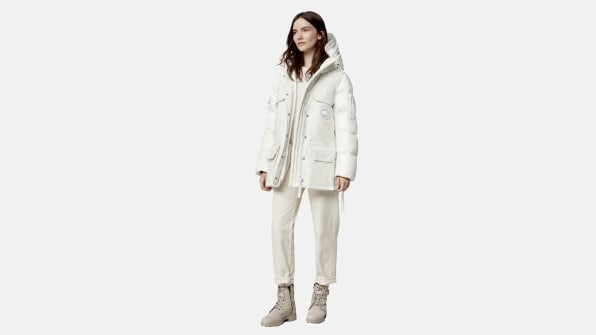Canada Goose’s signature Expedition Parka was designed for scientists in the coldest parts of the world, for temperatures down to -22 degrees Fahrenheit. Now, the company is achieving even more superlatives, after releasing an eco-conscious version of its famous parka. Deemed their “most sustainable parka to date,” the all-white sustainable parkas feature the same cut and details as their hip-grazing, front-pocketed Standard Expedition, but include green upgrades to the fabric, production, hardware, and even the store displays.
The sustainable Expedition Parka, which launched for both men and women ($1,850), was a year in the making. Woody Blackford, EVP of product at Canada Goose, set his sights on a product launch in line with the announcement of the brand’s Sustainable Impact Strategy last spring.
“What better than our most iconic and best-selling product?” says Blackford. “That became the goal. And then let’s use [the Expedition Parka] to create a standard for all of our products that we can percolate into the other parkas over the next few years.”
In its impact strategy, Canada Goose announced a variety of production standards and commitments, including using reclaimed fur and completing a Responsible Down Standard (RDS) certification. Both are reflected in the new jacket, which features 100% responsibly sourced down fill and reclaimed fur trim, along with recycled nylon, lining, shock cords, and zippers. The parka’s signature fabric, Arctic Tech, is a new blend of organic cotton and recycled polyester that stays soft and supple rather than crinkly in the extreme cold.
Blackford says he and his team consulted a spreadsheet of 50 or so design elements that he categorized as reduce, reuse, or recycle. The stark color—or as the brand calls it, greige (or as Blackford likes to call it, raw)—is also intentional, as bypassing the large-vat-required dyeing process helps save water consumption.

The jacket is still tested to the same standard as other performance outerwear from the brand — which includes a test chamber that simulates brutal winter weather with coat-wearing thermal mannequins that measure the coats’ effectiveness. But for us, Fast Company senior staff writer Elizabeth Segran tested the new coat against Boston’s frigid temperatures and wind.
While Segran says the new sustainable coat is very warm, living up to the high standards of other Canada Goose jackets, she also thought a lot about the aesthetic cues the brand made in this new venture. The new coat’s all-white label is a subtle contrast to larger logos and patches that signal the brand and luxury status.
“I think they’re trying to say they’re returning to a utilitarian approach,” Segran said. “They’re trying to make this jacket stand out without using the visual cues that might rub someone the wrong way, like a big red label on the side.”
Segran wore her coat to the grocery store and to run various errands and says it’s comfortable—easy to layer under with strategically placed zips to let air in or reconfigure the shape. The fabric was soft, but not quite as rugged as previous Canada Goose jackets she had tested. The extremely light color was easily susceptible to makeup and dirt. Segran compares it to a luxury handbag that can be babied and protected while in use, but “with a jacket, there are some things you can’t control, like where you’re sitting.”
She also notes other performance outerwear brands that have been reaching for transparent sustainability from inception, such as Everlane. But the luxury factor of the label makes a compelling case.
“From a fashion perspective, instead of signaling your wealth through a garment, you’re signaling your values toward sustainability,” she says. “I think what’s interesting is it suggests there’s an appetite in the market for wealthy consumers to project sustainability trust. Is that greenwashing, or virtue signaling in a nonserious way? I think it’s a good thing. They’re using that money to not just show how expensive something is, they’re projecting that they care about the planet.”
Canada Goose’s commitment to the environment is just beginning, but their efforts to move forward are as valuable as they are pragmatic.
“Being a company that makes things for extremely cold places, we’re learning firsthand how those places are changing more rapidly than we might feel in the places we live in,” says Blackwood. “We want to keep the planet cold because that’s what it needs to be healthy. And we can help keep people warm.”
(42)